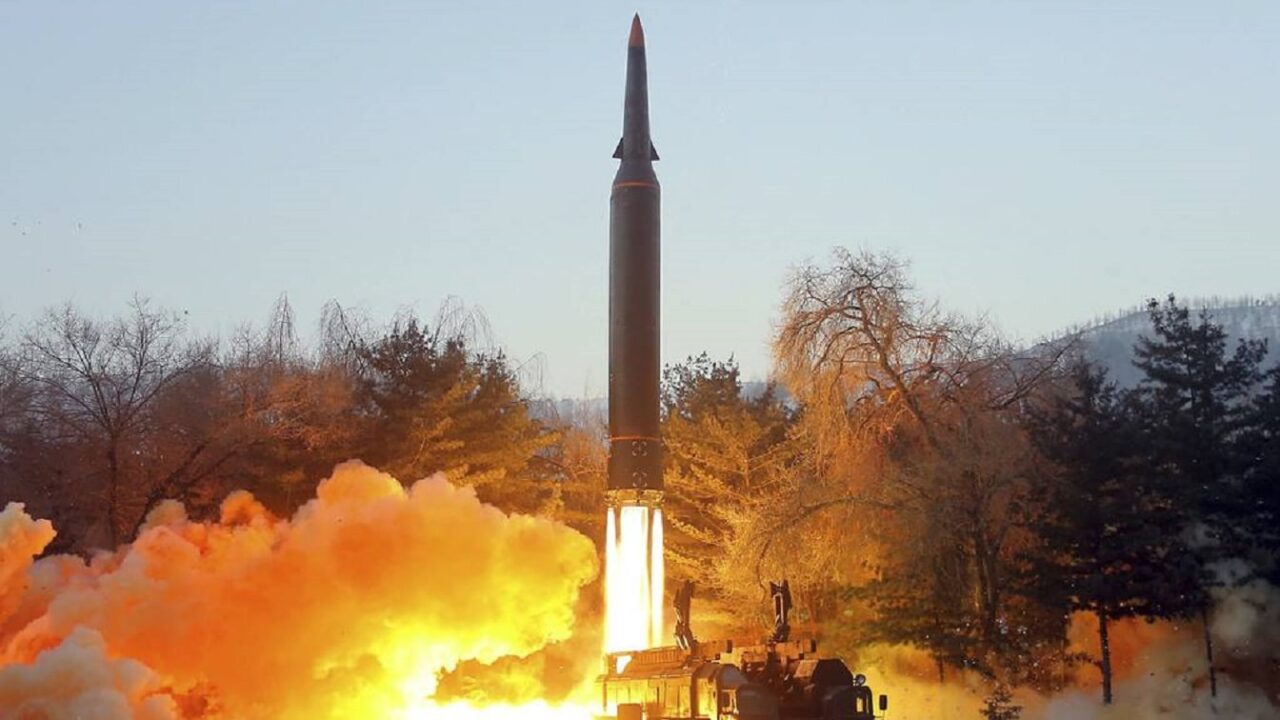North Korea has kicked off 2022 with a flurry of missile launches. While analysts were tempted to zero in on Kim Jong Un‘s agriculture and economy-focused remarks on new year’s day at a recent Workers’ Party of Korea plenum, national defense priorities haven’t fallen by the wayside. In fact, during his speech, Kim did call for the enhancement of military capabilities “without a moment’s delay.” Days later, the first missile launch of four so far in January took place.
The broader context for these launches is the military modernization agenda that Kim presented at the 8th Party Congress in January 2021. As part of a broader five-year plan of economic development, Kim ordered the development of a range of capabilities. These included maneuverable hypersonic weapons like the missile system tested across the first two tests this month. Kim personally attended and guided the second of these tests, on January 11, and underscored that hypersonic weapons were among the “core tasks” outlined at the Party Congress.
North Korean Missile Launches: A Signal or a True Test of Capabilities?
While analysts outside North Korea are tempted to read missile tests as cries for attention or signaling, most evidence points to a simpler explanation: North Korea is testing capabilities it perceives to be important for its national defense because the leadership thinks the development of military capability is important. Messaging to South Korea, the United States, and the broader world are sometimes factors, but secondary to this overarching goal.
There are other considerations as well. Internally, Kim has refocused on his national defense scientists and technical experts. This class received particular attention during the missile and nuclear testing campaign that ran between 2013 and 2017. The new five-year plan has brought them renewed prominence.
For instance, at a national defense expo held last October, two large photographs were prominently featured: one of Kim Jong Un alongside Pak Jong Chon, a senior military official involved personally with guiding missile tests in 2021, and another featuring Kim Jong Un flanked by Jang Chang Ha, Jon Il Ho, and Kim Jong Sik–three of the best-known North Korean officials involved in guiding the research, development, and testing of new missiles.
At a time when Kim has been open about internal economic difficulties in North Korea brought about by the Covid-19 pandemic, making sure that the development of new missiles succeeds can showcase positive developments for domestic reasons. A prominent theme in Kim’s tenure as North Korea’s leader so far has been an emphasis on pursuing economic development alongside a robust national defense; while the former isn’t going so well at the moment, Kim seeks to demonstrate that the latter remains largely unaffected by economic difficulties.
With regard to the outside world, it is notable that two of North Korea’s most recent launches have followed the Biden administration’s announcement of new sanctions against individuals and entities involved in facilitating the illicit procurement of materials and components used in the manufacture of missile systems. In the aftermath of this action, the North Korea Ministry of Foreign Affairs promised countermeasures.
A day later, North Korea carried out a rapid-reaction operational drill involving the launch of two short-range ballistic missiles from a railcar. The state media description of this test emphasized that the order to carry out the exercise was given on the very same day–emphasizing that this wasn’t something pre-planned like the earlier developmental tests of the maneuverable hypersonic weapon in the month.
The state media account of the fourth and most recent launch of two short-range ballistic missiles from Pyongyang’s Sunan Airport similarly made reference to the Second Economic Committee (SEC). The SEC is involved with, among other tasks, procurement for missile development and manufacture. While neither test made reference to U.S. sanctions or actions, these might have been designed to convey a degree of defiance. The broader point, however, remains that these tests primarily served to evaluate the readiness of the involved missile units.
All of this sets up 2022 as a potentially significant year for renewed North Korean missile testing. The 8th Party Congress agenda is clearly getting off the ground and Kim’s personal appearance at a missile test for the first time since March 2020 this month indicates high-level attention to these issues. The prospect of a return to diplomacy appears remote and North Korea may zero in on developing its capabilities further before revisiting talks with the United States.
Ankit Panda is the Stanton Senior Fellow in the Nuclear Policy Program at the Carnegie Endowment for International Peace. An expert on the Asia-Pacific region, his research interests range from nuclear strategy, arms control, missile defense, nonproliferation, emerging technologies, and U.S. extended deterrence. He is the author of Kim Jong Un and the Bomb: Survival and Deterrence in North Korea (Hurst Publishers/Oxford University Press, 2020).
A widely published writer, Panda’s work has appeared in the New York Times, the Washington Post, Foreign Affairs, Foreign Policy, the Bulletin of the Atomic Scientists, the Diplomat, the Atlantic, the New Republic, the South China Morning Post, War on the Rocks, Politico, and the National Interest. Panda has also published in scholarly journals, including Survival, the Washington Quarterly, and India Review, and has contributed to the IISS Asia-Pacific Regional Security Assessment and Strategic Survey. He is editor-at-large at the Diplomat, where he hosts the Asia Geopolitics podcast, and a contributing editor at War on the Rocks.

